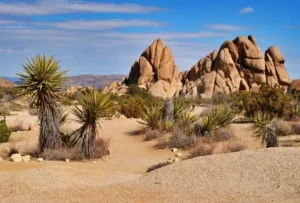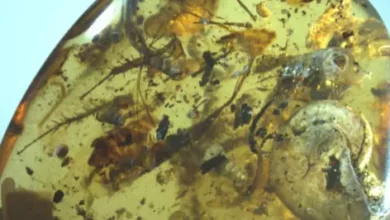The oldest plants: millennia on the planet
The list of longest-lived plants

The welwitschia ( Welwitschia mirabilis) is a unique plant of its kind. This species is endemic to the Namib Desert, located between Angola and Namibia. Each individual has a central trunk from which only two leaves emerge, which grow continuously to reach lengths of about 4 meters. The leaves separate into different fragments as they grow and are torn by the wind. The largest individual on record was 1.5 m tall but its leaves extended in a circumference of 8 m. These plants reproduce by means of seeds, which arise from striking red flowers that grow from the central stem. It is very difficult to calculate the age of these plants, but some are over 1,000 years old and could reach 2,000. Due to its peculiar characteristics, it is considered a living fossil.
A common characteristic of long-lived plants is that they have a slow development , due to the fact that they grow in environments that are poor in resources. Besides the welwitschia, another example of this is the Colorado pine ( Pinus aristata ), native to this region of the USA. It is a plant with a twisted trunk, which reaches a height of 6 m and has a slow growth, of a few centimeters a year. There are several thousand-year-old specimens, one of which has been dated at 2,480 years of age.
Another long-lived plant species, with a very peculiar appearance, is the yareta ( Azorella compacta ), native to the high plateau of the Andes. This plant forms circular clumps with a moss-like appearance and grows in nutrient-poor soils at altitudes of up to 5,000 meters. Each of the bushes can live up to 3,000 years , growing only 1.5 cm per year. Local people use these plants for fuel, but due to their slow growth it is not a sustainable practice.
The yew ( Taxus baccata ) is a species native to Europe that is characterized by the toxicity of its leaves and seeds. It is a conifer that can grow up to 20 m in height, is slow growing and reaches an age of up to 5,000 years. It is believed that it had a religious symbolism during the Middle Ages, because many were planted near Christian churches. Some of the oldest trees in Spain are yew trees , such as Borondillo (located in the Sierra de Guadarrama) or Bermiego (in the Asturian town of the same name), both with ages between 1,000 and 2,000 years.
The long-lived pine ( Pinus longaeva ) is a species of pine native to Nevada. It looks very similar to the Colorado pine, with a gnarled and twisted trunk, but this species is more long-lived. In 1964 a specimen that was more than 5,000 years old was cut for research purposes. These pines grow at high altitudes and in the oldest specimens only a bundle of living tissue connects the roots with a few living branches at the top of the twisted trunk. It is the longest known non-clonal plant species .

The suji or Japanese cryptomeria ( Cryptomeria japonica ) is a conifer endemic to Japan. This plant reaches a respectable height of 70 m and a trunk diameter of about 4 m. It can also be grown in the form of a small bonsai. The trees of this species can be thousand-year-old, with a specimen on the island of Yakushima with an estimated age of between 2,000 and 7,000 years. In the Tōshōgū shrine, in the town of Nikkō, there is an avenue of these trees with a length of 65 km that was planted by a Daimyō (a Japanese feudal lord) in the 15th century.
The Huon pine or Macquarie pine ( Lagarostrobos franklinii ) is a conifer native to Australia. It is not really a pine tree, despite its common name. This tree is slow growing but reaches heights of up to 30 m. Each individual tree can live up to 2,000 years, but they reproduce in a clonal way, so their longevity can be greater. It is the genetically identical set of clonal individuals that survives, not just one of the individual trees. Thus, a group of these trees has been found with an age of 10,500 years.
The yucca Mojave ( Yucca schidigera ) is another plant present in desert areas having a slow growth and clonal reproduction. It should not be confused with cassava, also called yuca ( Manihot esculenta ). Mojave yucca is a shrubby plant with a crown of long pointed leaves. These plants can be burned by natural fires and sprout again from their roots. Plants can grow in isolation or in clonal rings. The plant grows in height by 1 cm per year and can live up to 200 years, but much older clonal rings have been discovered, one of them 11,700 years old.
The Antarctic beech ( Nothofagus moorei ) is an evergreen tree native to the highlands of Australia. These trees can reach heights of 50 m. There are several closely related species that inhabit southern Chile, Argentina, Australia and New Zealand, which leads to think that they had a close ancestor located in the region of the supercontinent Gondwana that currently forms the Antarctic. Some clonal individuals of this species are 12,000 years old and can withstand very cold temperatures, down to -17 ° C.
The Palmer oak or Jarupa oak ( Quercus palmeri ) is a species of oak native to Arizona and Baja California. It does not usually grow more than three meters and has hard leaves with thorns similar to those of holly. The plant grows in small populations, some of which may be made up of clones of a single individual. These clones can live up to 13,000 years, which means that some of these plants date from the late Pleistocene.
The next plant on our list is not a species, but a clonal forest of aspen trees ( Populus tremuloides ) located in Utah, USA. This forest receives the name of Pando, which comes from the Latin “to extend”. This clonal organism extends 43 hectares, weighs about 6,000 tons altogether and is formed by a group of clonal trees interconnected by their roots, through which the exchange of water and other resources takes place. The forest is made up of about 40,000 trees, which gradually die and are replaced by others that sprout directly from the roots.
Each individual tree does not live more than 130 years, but the set of clones is estimated to be 14,000 years old. Some scientists put this figure up to one million years. In the parts of the forest that are burned by fire, trees can sprout from the seeds of the clone, which would therefore not be clones but new and independent individuals. As a curiosity, Pando is the second heaviest organism known, the first being a clonal colony of the Armillaria ostoyae fungus located in Oregon, spreading over an area of 910 hectares and weighing about 35,000 tons.
The royal lomatia or king’s holly ( Lomatia tasmanica ) is a peculiar plant. It is a shrubby plant that reaches a respectable height of 8 m. All individuals of this species are triploid, that is, they have their chromosomes in triplicate. Because of this, all plants are sterile and reproduction can only occur clonally (in the other plants on the list, reproduction could be sexual, and in some cases clonal as well). There is only one wild population of this plant, located in Tasmania, consisting of about 600 individuals growing in an area of 1.2 km 2 .
There are also individuals of royal lomatia in different botanical gardens, all of them clones of the wild population. The individuals in this population have a mean age of 60 years, some reaching 300. What then does this plant do on our list? After carefully studying the existing population, scientists have discovered that the clone has existed for thousands of years, estimating its age at a range between 43,000 and 135,000 years.
Recently another colony of clonal plants has been discovered occupying a large area, this time growing underwater. It is a colony of Posidonia oceanica that grows in Mediterranean waters, near Ibiza. Posidonia are not algae, but aquatic angiosperm plants (that is, plants that have flowers). These plants grow occupying large areas known as seagrass beds, serving as food and shelter for numerous animal and plant species. The clonal population located in Ibiza extends about 8 km and could be 100,000 years old. Thus, together with the royal lomatia clonal colony in Tasmania, it would be one of the longest-lived organisms on the planet.



